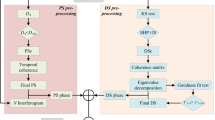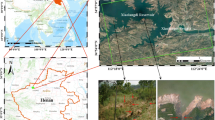Abstract
Due to the shortcomings of traditional interferometric synthetic aperture radar (InSAR) technologies in mining subsidence monitoring, such as a low density of monitoring points and difficulty obtaining fine surface deformation information, this paper proposes a mining area surface deformation monitoring method based on distributed scatterers InSAR while improving the phase information optimization strategy. This method obtains homogeneous points using the hypothesis test of confidence interval algorithm and constructs an adaptive phase optimization method based on the Goldstein principal phase filtering and Fisher information matrix weighting. It effectively preserves the information of deformation fringes, particularly in regions with dense interferometric fringes, and obtains detailed deformation information from the study area through time processing. In the experiments, 63 Sentinel-1 images were used to extract surface subsidence information for the Peibei mining area from September 24, 2018, to November 12, 2020. Compared with the Permanent Scatterers InSAR (PS-InSAR) results, the point density increased by a factor of 4.2. The correlation coefficient between the homonymous points obtained with the two methods and the deformation rate is 0.94, indicating that they have a good consistency. The monitoring results show that the six mining areas in Peibei have different degrees of subsidence during the monitoring period with a clear nonlinear trend, and the maximum cumulative subsidence over time exceeds 350 mm. The analysis shows that the improved DS-InSAR monitoring results are in line with the general law of mining subsidence and have practical application value.















Similar content being viewed by others
Abbreviations
- InSAR:
-
Interferometric synthetic aperture radar
- DS-InSAR:
-
Distributed scatterers InSAR
- PS-InSAR:
-
Permanent scatterers InSAR
- HTCI:
-
Hypothesis test of confidence interval
- FIM:
-
Fisher information matrix
- GNSS:
-
Global Navigation Satellite System
- SBAS-InSAR:
-
Small baseline subset InSAR
- TCP-InSAR:
-
Temporarily coherent point InSAR
- FaSHPS:
-
Fast statistically homogeneous pixel selection
- SHP:
-
Statistically homogeneous point
- PSD:
-
Phase standard deviation
- SPD:
-
Sum of phase differences
- RPN:
-
Residue point number
- g :
-
Gamma distribution
- α :
-
Significance level
- \(\hat{\mu }_{{{\text{ref}}}}\) :
-
The estimated value of the reference pixel
- \(\hat{\mu }\) :
-
The mean intensity of the other pixels in the window in the time domain
- H :
-
Filtered interferogram
- u v :
-
Spatial frequency
- \(S\left\{ \cdot \right\}\) :
-
Smoothing factor
- β :
-
Filtering index
- \(\overline{\gamma }\) :
-
The average coherence of the effective filtering window
- W :
-
The value of the phase optimization weight
- L :
-
Multi-look number
- \(\tilde{\gamma }\) :
-
Coherence
- \(\circ\) :
-
The Hadamard product between two matrices
- T :
-
Complex coherence matrix
- I :
-
Unit matrix
- \(\Omega\) :
-
Coherence estimation neighborhood
- \(s\left( \cdot \right)\) :
-
The complex SAR image used for interference
- D :
-
The number of SHPs in \(\Omega\)
- R :
-
The number of Bootstrap samples
- \(\gamma^{*}\) :
-
The coherence value for R samples
- \(\tilde{T}\) :
-
Reconstructed coherence matrix
- N :
-
The number of SAR images
References
Ansari H, De Zan F, Bamler R (2018) Efficient Phase estimation for interferogram stacks. IEEE Trans Geosci Remote Sens 56:4109–4125. https://doi.org/10.1109/tgrs.2018.2826045
Baran I, Stewart MP, Kampes BM, Perski Z, Lilly P (2003) A modification to the Goldstein radar interferogram filter. IEEE Trans Geosci Remote Sens 41:2114–2118. https://doi.org/10.1109/tgrs.2003.817212
Berardino P, Fornaro G, Lanari R, Sansosti E (2002) A new algorithm for surface deformation monitoring based on small baseline differential SAR interferograms. IEEE Trans Geosci Remote Sens 40:2375–2383. https://doi.org/10.1109/tgrs.2002.803792
Cao N, Lee H, Jung HC (2015) Mathematical framework for phase-triangulation algorithms in distributed-scatterer interferometry. IEEE Geosci Remote Sens Lett 12:1838–1842. https://doi.org/10.1109/lgrs.2015.2430752
Cao N, Lee H, Jung HC (2016) A phase-decomposition-based psinsar processing method. IEEE Trans Geosci Remote Sens 54:1074–1090. https://doi.org/10.1109/tgrs.2015.2473818
Du ZY, Ge LL, Ng AHM, Li XJ (2017) An innovative distributed scatterer based time-series InSAR method over an underground mining region. IGARSS. https://doi.org/10.1109/IGARSS.2017.8128028
Fan HD, Gao XX, Yang JK, Deng KZ, Yu Y (2015) Monitoring mining subsidence using a combination of phase-stacking and offset-tracking methods. Remote Sens 7:9166–9183. https://doi.org/10.3390/rs70709166
Fan HD, Liu YF, Xu YZ, Yang HL (2021) Surface subsidence monitoring with an improved distributed scatterer interferometric SAR time series method in a filling mining area. Geocarto Int 37:8979–9001. https://doi.org/10.1080/10106049.2021.2007300
Ferretti A, Prati C, Rocca F (2001) Permanent scatterers in SAR interferometry. IEEE Trans Geosci Remote Sens 39:8–20. https://doi.org/10.1109/36.898661
Fornaro G, Verde S, Reale D, Pauciullo A (2015) CAESAR: an approach based on covariance matrix decomposition to improve multibaseline-multitemporal interferometric SAR processing. IEEE Trans Geosci Remote Sens 53:2050–2065. https://doi.org/10.1109/tgrs.2014.2352853
Goldstein RM, Werner CL (1998) Radar interferogram filtering for geophysical applications. Geophys Res Lett 25:4035–4038
Goldstein RM, Zebker HA, Werner CL (1988) Satellite radar interferometry: two-dimensional phase unwrapping. Radio Sci 23:713–720
Guarnieri AM, Tebaldini S (2007) Hybrid Cramer-Rao bounds for crustal displacement field estimators in SAR interferometry. IEEE Signal Process Lett 14:1012–1015. https://doi.org/10.1109/lsp.2007.904705
Guarnieri AM, Tebaldini S (2008) On the exploitation of target statistics for SAR interferometry applications. IEEE Trans Geosci Remote Sens 46:3436–3443. https://doi.org/10.1109/tgrs.2008.2001756
Jiang M, Ding XL, Li ZW (2014) Hybrid approach for unbiased coherence estimation for multitemporal InSAR. IEEE Trans Geosci Remote Sens 52:2459–2473. https://doi.org/10.1109/tgrs.2013.2261996
Jiang M, Ding XL, Hanssen RF, Malhotra R, Chang L (2015) Fast statistically homogeneous pixel selection for covariance matrix estimation for multitemporal InSAR. IEEE Trans Geosci Remote Sens 53:1213–1224. https://doi.org/10.1109/tgrs.2014.2336237
Jiang M, Yong B, Tian X, Malhotra R, Hu R, Li ZW, Yu ZB, Zhang XX (2017) The potential of more accurate InSAR covariance matrix estimation for land cover mapping. ISPRS-J Photogramm Remote Sens 126:120–128. https://doi.org/10.1016/j.isprsjprs.2017.02.009
Jiang M, Ding XL, Li ZW (2018) Research on homogeneous sample selection algorithm for time series InSAR. Chin J Geophys 61:4767–4776
Li ZL, Zou WB, Ding XL, Chen YQ, Liu GX (2004) A quantitative measure for the quality of INSAR interferograms based on phase differences. Photogramm Eng Remote Sens 70:1131–1137. https://doi.org/10.14358/pers.70.10.1131
Li JC, Gao F, Lu JG (2019) An application of InSAR time-series analysis for the assessment of mining-induced structural damage in Panji Mine, China. Nat Hazards 97:243–258. https://doi.org/10.1007/s11069-019-03639-8
Li YX, Yang KM, Zhang JH, Hou ZX, Wang S, Ding XM (2022) Research on time series InSAR monitoring method for multiple types of surface deformation in mining area. Nat Hazards 114:2479–2508. https://doi.org/10.1007/s11069-022-05476-8
Liu JL, Wang YJ, Li Y, Dang LB, Liu XX, Zhao HF, Yan SY (2019) Underground coal fires identification and monitoring using time-series InSAR with persistent and distributed scatterers: a case study of miquan coal fire zone in Xinjiang, China. IEEE Access 7:164492–164506. https://doi.org/10.1109/access.2019.2952363
Mestre-Quereda A, Lopez-Sanchez JM, Selva J, Gonzalez PJ (2018) An improved phase filter for differential SAR interferometry based on an iterative method. IEEE Trans Geosci Remote Sens 56:4477–4491. https://doi.org/10.1109/tgrs.2018.2820725
Ministry of Natural Resources P M (2021) China mineral resources. Geological Publishing House, Beijing
Oliver C, Quegan SM (2004) Understanding synthetic aperture radar images. SciTech Publishing, California
Shamshiri R, Nahavandchi H, Motagh M, Hooper A (2018) Efficient ground surface displacement monitoring using sentinel-1 data: integrating distributed scatterers (DS) identified using two-sample t-test with persistent scatterers (PS). Remote Sens 10:14. https://doi.org/10.3390/rs10050794
Shi GQ, Ma PF, Lin H, Huang B, Zhang BW, Liu YZ (2020) Potential of using phase correlation in distributed scatterer InSAR applied to built scenarios. Remote Sens 12:24. https://doi.org/10.3390/rs12040686
Wang YL, Liu WJ, Xie WC (2014) Reduced-rank space-time adaptive detection for airborne radar Science China (Information Sciences)
Wang YY, Zhu XX (2016) Robust estimators for multipass SAR interferometry. IEEE Trans Geosci Remote Sens 54:968–980. https://doi.org/10.1109/tgrs.2015.2471303
Zhang L, Ding XL, Lu Z (2011) Ground settlement monitoring based on temporarily coherent points between two SAR acquisitions. ISPRS J Photogramm 66(1):146–152
Zhang Q, Huang GW, Yang CS (2017) Precision space earth observation technology in geological disaster monitoring and early warning. Acta Geodaetica Et Cartographica Sinica 61:1300–1307
Zhao CJ, Li Z, Tian BS, Zhang P, Chen Q (2019) A ground surface deformation monitoring InSAR method using improved distributed scatterers phase estimation. IEEE J Sel Top Appl Earth Observ Remote Sens 12:4543–4553. https://doi.org/10.1109/jstars.2019.2946729
Acknowledgements
The authors would like to thank the European Space Agency for providing Sentinel-1A data.
Funding
The research work was funded by the Natural Science Foundation of China (No. 42274054, 51774270); Key Laboratory of Land Satellite Remote Sensing Application, Ministry of Natural Resources of the People's Republic of China (No. KLSMNR-G202218); Intergovernmental International Scientific and Technological Innovation Cooperation Project (No. 2017YFE0107100).
Author information
Authors and Affiliations
Corresponding author
Ethics declarations
Conflict of interest
The authors have no relevant financial or non-financial interests to disclose.
Additional information
Publisher's Note
Springer Nature remains neutral with regard to jurisdictional claims in published maps and institutional affiliations.
Rights and permissions
Springer Nature or its licensor (e.g. a society or other partner) holds exclusive rights to this article under a publishing agreement with the author(s) or other rightsholder(s); author self-archiving of the accepted manuscript version of this article is solely governed by the terms of such publishing agreement and applicable law.
About this article
Cite this article
Tian, Z., Zhao, L., Fan, H. et al. Mining subsidence monitoring using distributed scatterers InSAR based on Goldstein filter and Fisher information matrix-weighted optimization. Nat Hazards 120, 4205–4231 (2024). https://doi.org/10.1007/s11069-023-06359-2
Received:
Accepted:
Published:
Issue Date:
DOI: https://doi.org/10.1007/s11069-023-06359-2




